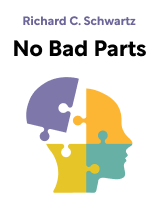

This article is an excerpt from the Shortform book guide to "No Bad Parts" by Richard C. Schwartz. Shortform has the world's best summaries and analyses of books you should be reading.
Like this article? Sign up for a free trial here.
Have you ever felt like a part of you is telling you one thing, while another part is saying the opposite? Why do we sometimes desire and feel things that contradict one another?
According to psychiatrist Richard Schwartz, conflicting internal voices are totally normal. He suggests that, instead of being only one person, we all hold subpersonalities within ourselves that relate to each other in the same ways that members of a family might relate to one another.
Keep reading to learn about the psychology behind subpersonalities.
What Are Subpersonalities?
Each of our subpersonalities is a piece of who we are. They have their own goals and motivations, even memories, and different levels of wisdom, maturity, and emotionality. They might take on different forms or be a younger version of ourselves.
All of our parts have good intentions for us, but parts can sometimes get trapped in roles that make them act in extreme, unproductive, or destructive ways. For example, someone who has experienced abuse as a child might have a part that’s trapped in that traumatized place, and a part who, out of a protective instinct, routinely sabotages intimate relationships for fear of getting hurt.
| Why Parts Get Stuck In an earlier book, Internal Family Systems Therapy, Schwartz goes into more detail about why parts can get stuck in unproductive roles. He outlines several root causes not discussed in No Bad Parts that can prevent a part from being willing to give up these roles. Reason 1: The part is in extreme conflict with another part. Sometimes two parts are at odds with one another and both pulling in extreme and opposite directions. For example, one part might want to switch careers, while another part is adamantly opposed to risking a stable income. Reason 2: Parts can get trapped in the past. Some parts are stuck in a past memory or time and require an update on how life has changed in order to step out of the role they’ve taken on. Reason 3: The part is triggered by their external environment. Sometimes a part won’t step out of a role if it is consistently triggered by something in its external environment. For example, if a person is financially unstable, a highly risk-averse part might be unwilling to step out of that role. Reason 4: The part is struggling with the therapist. Sometimes the problem can be the therapeutic relationship itself. If a part doesn’t trust the therapist, or is ashamed or embarrassed by something, they’re unlikely to step out of their role. |
Like getting to know our Self, the first step in getting to know our parts is practicing greater self-awareness. When do certain emotions come up and why? For example, imagine you have dinner plans with a friend and they show up 40 minutes late. If part of you feels deeply angry at your friend, that angry part might be a defense mechanism to protect you from the deeper fear of being abandoned. Paying closer attention to your emotional landscape will help you get to know the parts in your inner family system.
(Shortform note: Self-awareness is the recognition of your physical, mental, and emotional state, as well as the ability to see yourself from someone else’s perspective. In addition to observing your emotions, there are other methods to increase your self-awareness. For example, in Emotional Intelligence 2.0, Travis Bradberry and Jean Greaves recommend tactics such as withholding judgment, journaling, identifying root causes, and embracing discomfort.)
While Schwartz emphasizes that all internal family systems are unique to the individual, our parts tend to organize themselves into one of two categories: vulnerable parts (called exiles) and protective parts.
Exiles
Schwartz refers to our vulnerable parts as exiles. Exiles are the youngest and most vulnerable versions of who we are, sometimes referred to as our “inner children.” They’re often the parts that have directly experienced some kind of trauma and then took on the burden of those emotions, leaving them trapped in the past.
While these inner children are often sweet, innocent, playful, and trusting, they’re also highly sensitive and prone to being hurt. Exiles are the parts of ourselves that we’re most likely to hide because we don’t want to experience their hurt or shame. For example, imagine you were yelled at for crying when you were a young child. This might create an exiled part of you that feels shame anytime you cry in front of other people.
Protectors
Meanwhile, our protective parts are the parts of ourselves that take on the role of defending our exiles from future hurt. To continue the above example—if there was an exile that felt shame for crying publicly, there might be a protector who shows up when the exile is feeling especially sad who tells the exile to “suck it up.” Schwartz emphasizes that where there are exiles, there are always protectors.
Schwartz distinguishes between two types of protectors. Managers are protective parts that act preemptively to keep us safe by attempting to control our environment—carefully managing who we date, what we wear, and how we’re perceived to ensure that nothing can happen to trigger the same feelings experienced by our exiles. Managers are often our most critical inner voices. Their burden is containing and protecting the most vulnerable parts of who we are.
Firefighters are protective parts that act reactively when they think we’re in danger—usually when there’s an overwhelming flood of emotions. Firefighters want to remove us from what we’re feeling. They might make us throw ourselves into work, binge-watch a show, use substances to numb pain, or, in extreme cases, commit suicide, in an attempt to remove us from what we’re feeling. Their burden is suppressing powerful emotions when they do flare up.

———End of Preview———
Like what you just read? Read the rest of the world's best book summary and analysis of Richard C. Schwartz's "No Bad Parts" at Shortform.
Here's what you'll find in our full No Bad Parts summary:
- A detailed look at IFS—a psychotherapy model that challenges the idea of a unitary mind
- Why it's normal to have conflicting voices in your head
- What IFS therapy looks like in practice and its benefits






